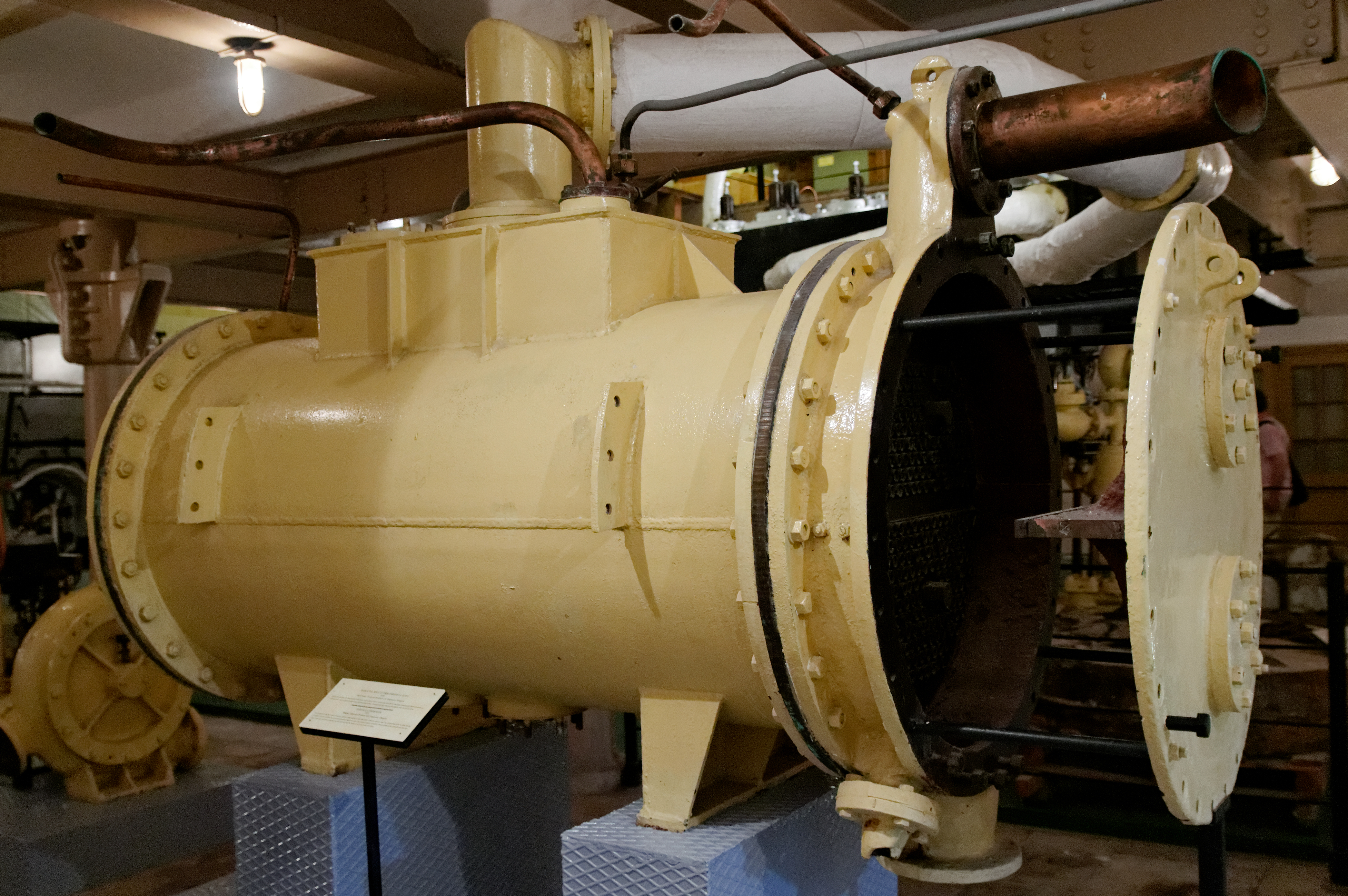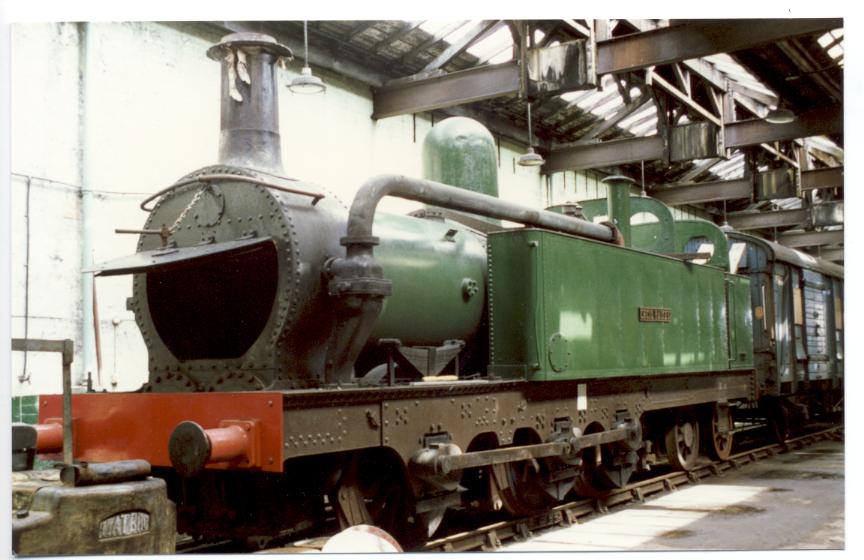|
Condensers
__NOTOC__ Condenser may refer to: Heat transfer * Condenser (heat transfer), a device or unit used to condense vapor into liquid. Specific types include: ** HVAC air coils ** Condenser (laboratory), a range of laboratory glassware used to remove heat from fluids ** Surface condenser, a heat exchange installed in steam-electric power stations to condense turbine exhaust steam into water ** Isolation condenser, an emergency passive system for cooling in some reactors (BWR/2, BWR/3 and SBWR series) in nuclear energy production Steam engines * Condensing steam locomotive * Jet condenser * Surface condenser Other uses * Condensers for collecting atmospheric moisture: ** Air well (condenser) ** Atmospheric water generator * Condenser (optics), a lens which gathers visible light and directs it onto a projection lens to concentrate it * Capacitor, formerly called a condenser, an electrical device that stores energy * Condenser microphone, a capacitor-based microphone that converts ... [...More Info...] [...Related Items...] OR: [Wikipedia] [Google] [Baidu] |
Condenser (heat Transfer)
In systems involving heat transfer, a condenser is a heat exchanger used to condense a gaseous substance into a liquid state through cooling. In so doing, the latent heat is released by the substance and transferred to the surrounding environment. Condensers are used for efficient heat rejection in many industrial systems. Condensers can be made according to numerous designs, and come in many sizes ranging from rather small (hand-held) to very large (industrial-scale units used in plant processes). For example, a refrigerator uses a condenser to get rid of heat extracted from the interior of the unit to the outside air. Condensers are used in air conditioning, industrial chemical processes such as distillation, steam power plants and other heat-exchange systems. Use of cooling water or surrounding air as the coolant is common in many condensers. History The earliest laboratory condenser, a " Gegenstromkühler" (counter-flow condenser), was invented in 1771 by the Swedish-Ger ... [...More Info...] [...Related Items...] OR: [Wikipedia] [Google] [Baidu] |
Condenser (optics)
A condenser is an optical lens which renders a divergent beam from a point source into a parallel or converging beam to illuminate an object. Condensers are an essential part of any imaging device, such as microscopes, enlargers, slide projectors, and telescopes. The concept is applicable to all kinds of radiation undergoing optical transformation, such as electrons in electron microscopy, neutron radiation and synchrotron radiation optics. Microscope condenser Condensers are located above the light source and under the sample in an upright microscope, and above the stage and below the light source in an inverted microscope. They act to gather light from the microscope's light source and concentrate it into a cone of light that illuminates the specimen. The aperture and angle of the light cone must be adjusted (via the size of the diaphragm) for each different objective lens with different numerical apertures. Condensers typically consist of a variable-aperture diaphragm and ... [...More Info...] [...Related Items...] OR: [Wikipedia] [Google] [Baidu] |
Air Well (condenser)
An air well or aerial well is a structure or device that collects water by promoting the condensation of moisture from air. Designs for air wells are many and varied, but the simplest designs are completely passive, require no external energy source and have few, if any, moving parts. Three principal designs are used for air wells, designated as high mass, radiative, and active: * High-mass air wells: used in the early 20th century, but the approach failed. * Low-mass, radiative collectors: Developed in the late 20th century onwards, proved to be much more successful. * Active collectors: these collect water in the same way as a dehumidifier; although the designs work well, they require an energy source, making them uneconomical except in special circumstances. New, innovative designs seek to minimise the energy requirements of active condensers or make use of sustainable and renewable energy resources. Background All air well designs incorporate a substrate with a tem ... [...More Info...] [...Related Items...] OR: [Wikipedia] [Google] [Baidu] |
Surface Condenser
A surface condenser is a water-cooled shell and tube heat exchanger installed to condense exhaust steam from a steam turbine in thermal power stations. These condensers are heat exchangers which convert steam from its gaseous to its liquid state at a pressure below atmospheric pressure. Where cooling water is in short supply, an air-cooled condenser is often used. An air-cooled condenser is however, significantly more expensive and cannot achieve as low a steam turbine exhaust pressure (and temperature) as a water-cooled surface condenser. Surface condensers are also used in applications and industries other than the condensing of steam turbine exhaust in power plants. Purpose In thermal power plants, the purpose of a surface condenser is to condense the exhaust steam from a steam turbine to obtain maximum efficiency, and also to convert the turbine exhaust steam into pure water (referred to as steam condensate) so that it may be reused in the steam generator or boiler as boi ... [...More Info...] [...Related Items...] OR: [Wikipedia] [Google] [Baidu] |
Condenser (laboratory)
In chemistry, a condenser is laboratory apparatus used to condense vaporsthat is, turn them into liquidsby cooling them down. Condensers are routinely used in laboratory operations such as distillation, reflux, and extraction. In distillation, a mixture is heated until the more volatile components boil off, the vapors are condensed, and collected in a separate container. In reflux, a reaction involving volatile liquids is carried out at their boiling point, to speed it up; and the vapors that inevitably come off are condensed and returned to the reaction vessel. In Soxhlet extraction, a hot solvent is infused onto some powdered material, such as ground seeds, to leach out some poorly soluble component; the solvent is then automatically distilled out of the resulting solution, condensed, and infused again. Many different types of condensers have been developed for different applications and processing volumes. The simplest and oldest condenser is just a long tube throu ... [...More Info...] [...Related Items...] OR: [Wikipedia] [Google] [Baidu] |
Heat Exchanger
A heat exchanger is a system used to transfer heat between a source and a working fluid. Heat exchangers are used in both cooling and heating processes. The fluids may be separated by a solid wall to prevent mixing or they may be in direct contact. They are widely used in space heating, refrigeration, air conditioning, power stations, chemical plants, petrochemical plants, petroleum refineries, natural-gas processing, and sewage treatment. The classic example of a heat exchanger is found in an internal combustion engine in which a circulating fluid known as engine coolant flows through radiator coils and air flows past the coils, which cools the coolant and heats the incoming air. Another example is the heat sink, which is a passive heat exchanger that transfers the heat generated by an electronic or a mechanical device to a fluid medium, often air or a liquid coolant. Flow arrangement Image:Heat_exc_1-1.svg, Fig. 1: Shell and tube heat exchanger, single pass (1–1 ... [...More Info...] [...Related Items...] OR: [Wikipedia] [Google] [Baidu] |
Condenser (steam Engine)
__NOTOC__ Condenser may refer to: Heat transfer * Condenser (heat transfer), a device or unit used to condense vapor into liquid. Specific types include: ** HVAC air coils ** Condenser (laboratory), a range of laboratory glassware used to remove heat from fluids ** Surface condenser, a heat exchange installed in steam-electric power stations to condense turbine exhaust steam into water ** Isolation condenser, an emergency passive system for cooling in some reactors (BWR/2, BWR/3 and SBWR series) in nuclear energy production Steam engines * Condensing steam locomotive * Jet condenser * Surface condenser Other uses * Condensers for collecting atmospheric moisture: ** Air well (condenser) ** Atmospheric water generator * Condenser (optics), a lens which gathers visible light and directs it onto a projection lens to concentrate it * Capacitor, formerly called a condenser, an electrical device that stores energy * Condenser microphone, a capacitor-based microphone that converts so ... [...More Info...] [...Related Items...] OR: [Wikipedia] [Google] [Baidu] |
Capacitor
A capacitor is a device that stores electrical energy in an electric field by virtue of accumulating electric charges on two close surfaces insulated from each other. It is a passive electronic component with two terminals. The effect of a capacitor is known as capacitance. While some capacitance exists between any two electrical conductors in proximity in a circuit, a capacitor is a component designed to add capacitance to a circuit. The capacitor was originally known as the condenser, a term still encountered in a few compound names, such as the '' condenser microphone''. The physical form and construction of practical capacitors vary widely and many types of capacitor are in common use. Most capacitors contain at least two electrical conductors often in the form of metallic plates or surfaces separated by a dielectric medium. A conductor may be a foil, thin film, sintered bead of metal, or an electrolyte. The nonconducting dielectric acts to increase the capacitor's ... [...More Info...] [...Related Items...] OR: [Wikipedia] [Google] [Baidu] |
Synchronous Condenser
In electrical engineering, a synchronous condenser (sometimes called a syncon, synchronous capacitor or synchronous compensator) is a DC-excited synchronous motor, whose shaft is not connected to anything but spins freely.B. M. Weedy, Electric Power Systems Second Edition, John Wiley and Sons, London, 1972, page 149 Its purpose is not to convert electric power to mechanical power or vice versa, but to adjust conditions on the electric power transmission grid. Its field is controlled by a voltage regulator to either generate or absorb reactive power as needed to adjust the grid's voltage, or to improve power factor. The condenser’s installation and operation are identical to large electric motors and generators (some generators are actually designed to be able to operate as synchronous condensers with the prime mover disconnected). Increasing the device's field excitation results in its furnishing reactive power (measured in units of var) to the system. Its principal advant ... [...More Info...] [...Related Items...] OR: [Wikipedia] [Google] [Baidu] |
Isolation Condenser
In a reactor core isolation cooling system ("RCIC"), an isolation condenser (IC or iso. condenser; also isolation condenser system) is one of the emergency reactor safety systems in some nuclear plants (boiling water reactor safety systems Boiling water reactor safety systems are nuclear safety systems constructed within boiling water reactors in order to prevent or mitigate environmental and health hazards in the event of accident or natural disaster. Like the pressurized wate ...). Emergency passive system It is a passive system for cooling of some reactors (BWR/2, BWR/3 ..., and the (E)SBWR series) in nuclear production, located above containment in a pool of water open to atmosphere. In operation, decay heat boils steam, which is drawn into the heat exchanger and condensed; then it falls by weight of gravity back into the reactor. This process keeps the cooling water in the reactor, making it unnecessary to use powered feedwater pumps. The water in the open pool slowly b ... [...More Info...] [...Related Items...] OR: [Wikipedia] [Google] [Baidu] |
Condensing Steam Locomotive
A condensing steam locomotive is a type of locomotive designed to recover exhaust steam, either in order to improve range between taking on boiler water, or to reduce emission of steam inside enclosed spaces. The apparatus takes the exhaust steam that would normally be used to produce a draft for the firebox, and routes it through a heat exchanger, into the boiler water tanks. Installations vary depending on the purpose, design and the type of locomotive to which it is fitted. It differs from the usual closed cycle condensing steam engine, in that the function of the condenser is primarily either to recover water, or to avoid excessive emissions to the atmosphere, rather than maintaining a vacuum to improve both efficiency and power. Thermodynamics Unlike the surface condenser often used on a steam turbine or marine steam engine, the condensing apparatus on a steam locomotive does not normally increase the power output, rather it decreases due to a reduction of airflow to t ... [...More Info...] [...Related Items...] OR: [Wikipedia] [Google] [Baidu] |
Jet Condenser
The Watt steam engine design became synonymous with steam engines, and it was many years before significantly new designs began to replace the basic Watt design. The first steam engines, introduced by Thomas Newcomen in 1712, were of the "atmospheric" design. At the end of the power stroke, the weight of the object being moved by the engine pulled the piston to the top of the cylinder as steam was introduced. Then the cylinder was cooled by a spray of water, which caused the steam to condense, forming a partial vacuum in the cylinder. Atmospheric pressure on the top of the piston pushed it down, lifting the work object. James Watt noticed that it required significant amounts of heat to warm the cylinder back up to the point where steam could enter the cylinder without immediately condensing. When the cylinder was warm enough that it became filled with steam the next power stroke could commence. Watt realised that the heat needed to warm the cylinder could be saved by adding ... [...More Info...] [...Related Items...] OR: [Wikipedia] [Google] [Baidu] |





.jpg)


